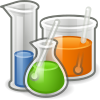Physical chemistry

| Part of a series on |
| Chemistry |
|---|
 |
Physical chemistry is the study of macroscopic and microscopic phenomena in chemical systems in terms of the principles, practices, and concepts of physics such as motion, energy, force, time, thermodynamics, quantum chemistry, statistical mechanics, analytical dynamics and chemical equilibria.
Physical chemistry, in contrast to chemical physics, is predominantly (but not always) a supra-molecular science, as the majority of the principles on which it was founded relate to the bulk rather than the molecular or atomic structure alone (for example, chemical equilibrium and colloids).
Some of the relationships that physical chemistry strives to understand include the effects of:
- Intermolecular forces that act upon the physical properties of materials (plasticity, tensile strength, surface tension in liquids).
- Reaction kinetics on the rate of a reaction.
- The identity of ions and the electrical conductivity of materials.
- Surface science and electrochemistry of cell membranes.[1]
- Interaction of one body with another in terms of quantities of heat and work called thermodynamics.
- Transfer of heat between a chemical system and its surroundings during change of phase or chemical reaction taking place called thermochemistry
- Study of colligative properties of number of species present in solution.
- Number of phases, number of components and degree of freedom (or variance) can be correlated with one another with help of phase rule.
- Reactions of electrochemical cells.
- Behaviour of microscopic systems using quantum mechanics and macroscopic systems using statistical thermodynamics.
- Calculation of the energy of electron movement in molecules and metal complexes.
Key concepts
The key concepts of physical chemistry are the ways in which pure physics is applied to chemical problems.
One of the key concepts in classical chemistry is that all
Disciplines
Quantum chemistry, a subfield of physical chemistry especially concerned with the application of quantum mechanics to chemical problems, provides tools to determine how strong and what shape bonds are,[2] how nuclei move, and how light can be absorbed or emitted by a chemical compound.[3] Spectroscopy is the related sub-discipline of physical chemistry which is specifically concerned with the interaction of electromagnetic radiation with matter.
Another set of important questions in chemistry concerns what kind of reactions can happen spontaneously and which properties are possible for a given chemical mixture. This is studied in
Which reactions do occur and how fast is the subject of
The fact that how fast reactions occur can often be specified with just a few concentrations and a temperature, instead of needing to know all the positions and speeds of every molecule in a mixture, is a special case of another key concept in physical chemistry, which is that to the extent an engineer needs to know, everything going on in a mixture of very large numbers (perhaps of the order of the Avogadro constant, 6 x 1023) of particles can often be described by just a few variables like pressure, temperature, and concentration. The precise reasons for this are described in statistical mechanics,[8] a specialty within physical chemistry which is also shared with physics. Statistical mechanics also provides ways to predict the properties we see in everyday life from molecular properties without relying on empirical correlations based on chemical similarities.[5]
History

The term "physical chemistry" was coined by
Modern physical chemistry originated in the 1860s to 1880s with work on
The first
Developments in the following decades include the application of
Further development in physical chemistry may be attributed to discoveries in nuclear chemistry, especially in isotope separation (before and during World War II), more recent discoveries in astrochemistry,[12] as well as the development of calculation algorithms in the field of "additive physicochemical properties" (practically all physicochemical properties, such as boiling point, critical point, surface tension, vapor pressure, etc.—more than 20 in all—can be precisely calculated from chemical structure alone, even if the chemical molecule remains unsynthesized),[citation needed] and herein lies the practical importance of contemporary physical chemistry.
See
Journals
Some journals that deal with physical chemistry include
- Zeitschrift für Physikalische Chemie (1887)
- Journal of Physical Chemistry A(from 1896 as Journal of Physical Chemistry, renamed in 1997)
- Faraday Transactionswith a history dating back to 1905)
- Macromolecular Chemistry and Physics (1947)
- Annual Review of Physical Chemistry (1950)
- Molecular Physics (1957)
- Journal of Physical Organic Chemistry (1988)
- Journal of Physical Chemistry B(1997)
- ChemPhysChem (2000)
- Journal of Physical Chemistry C(2007)
- Journal of Physical Chemistry Letters(from 2010, combined letters previously published in the separate journals)
Historical journals that covered both chemistry and physics include Annales de chimie et de physique (started in 1789, published under the name given here from 1815 to 1914).
Branches and related topics
See also
- List of important publications in chemistry#Physical chemistry
- List of unsolved problems in chemistry#Physical chemistry problems
- Physical biochemistry
- Category:Physical chemists
References
- ISBN 0-8247-1922-0.
- ^ ISBN 0-19-927498-3.
- ISBN 0-19-927498-3.
- ISBN 0-7506-3372-7.
- ^ ISBN 0-486-65242-4.
- ISBN 0-19-516925-5.
- ISBN 0-19-516925-5.
- ISBN 978-0-19-504277-1.
- ISBN 0-8047-0738-3.
- ^ Josiah Willard Gibbs, 1876, "On the Equilibrium of Heterogeneous Substances", Transactions of the Connecticut Academy of Sciences
- ISBN 0-19-855919-4.
- PMID 16833724.
External links
- The World of Physical Chemistry (Keith J. Laidler, 1993)
- Physical Chemistry from Ostwald to Pauling (John W. Servos, 1996)
- Physical Chemistry: neither Fish nor Fowl? (Joachim Schummer, The Autonomy of Chemistry, Würzburg, Königshausen & Neumann, 1998, pp. 135–148)
- The Cambridge History of Science: The modern physical and mathematical sciences (Mary Jo Nye, 2003)
